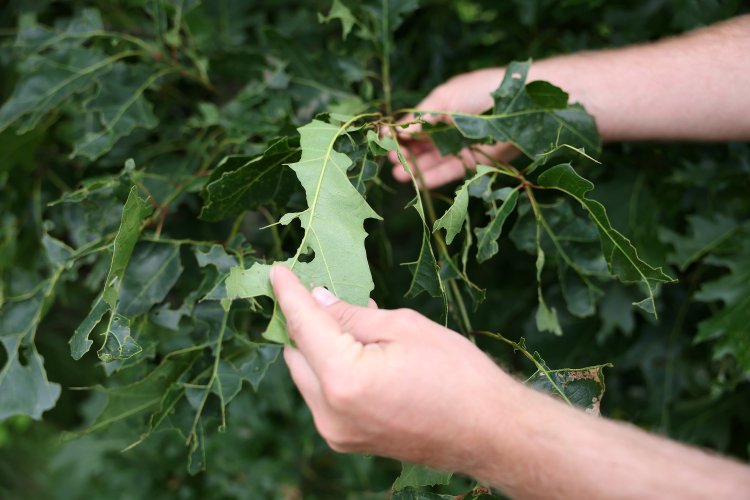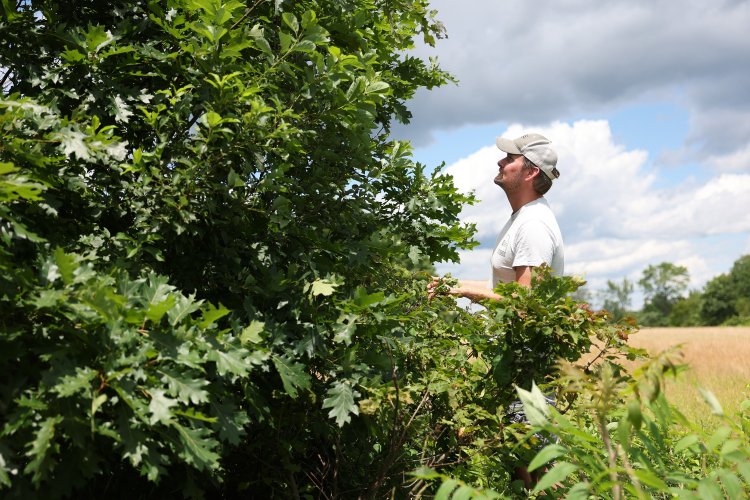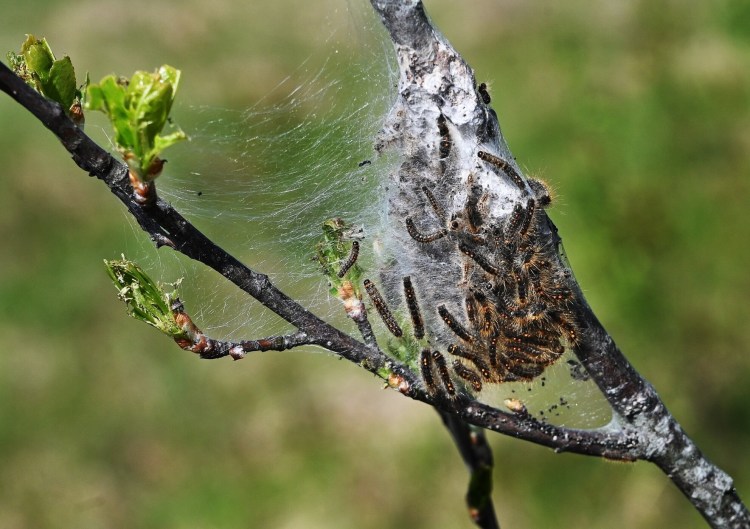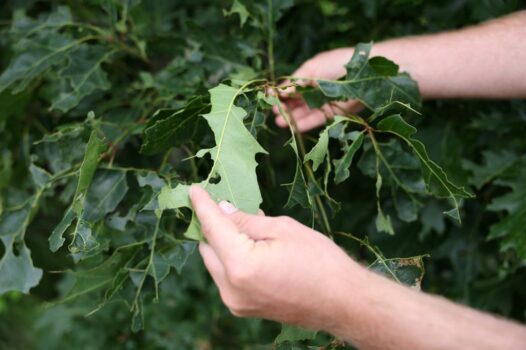

Tom Schmeelk, an entomologist with the Maine Forest Service, factors out the place feeding harm from browntail caterpillars is clear on the leaves of a northern pink oak sapling. A fungus knocked again populations of browntail moths this spring, though scientists should not certain by how a lot. Ben McCanna/Workers Photographer
A fungus that kills browntail moth caterpillars seems to have knocked again populations of the perennial pest in parts of Maine this spring, offering a reprieve from the annual struggling brought on by the tiny hairs they launch into the air.
But it surely’s too early to know whether or not the fungus will assist spur a statewide inhabitants collapse of the forest pest or if that is the beginning of a protracted break within the yearslong infestation that has unfold alongside the coast and inland.
Microscopic hairs from the caterpillars could cause an especially itchy, lingering rash in folks, usually from Could to mid- to late June, earlier than the grownup caterpillars pupate and rework into moths. Along with a rash, signs can embrace respiratory issues, together with issue respiratory and irritation of the lungs and throat.
There isn’t any information that may present how many individuals expertise these signs, however potential publicity to the microscopic hairs is linked to how strong the inhabitants of browntail moth caterpillars is every year.
Thomas Schmeelk, an entomologist with the Maine Forest Service, mentioned the climate this spring created “Goldilocks” circumstances for the fungus to proliferate and kill the caterpillars – not too dry and never too wet. A virus that kills the caterpillars – additionally tied to climate circumstances – has additionally contributed to lowering browntail moth populations.
“We now have many reviews of the fungus and the virus all through the infested areas of the state, and it’s a reasonably large swath. It’s an excellent signal. We’re hopeful that is the start of the tip for this outbreak (of browntail moths),” Schmeelk mentioned.
Whereas rain helps develop the fungus, an excessive amount of rain, like the consistent rainy conditions in spring 2023, suppresses the proliferation of the fungus, which made it much less efficient in controlling browntail moth populations final spring, he mentioned.
However this 12 months, periodic heavy rainstorms have typically been adopted by a number of days of dry climate, which has helped to disperse the fungus, Schmeelk mentioned. Spores from the fungus – entomophaga aulicae – want a break within the moist climate in order that wind can carry them to different areas to contaminate extra caterpillars.


Tom Schmeelk, an entomologist with the Maine Forest Service, scans a gaggle of northern pink oak saplings for pupal packets the place feeding harm from browntail caterpillars is clear. Ben McCanna/Workers Photographer
Schmeelk mentioned an aerial surveillance of leaf cover this August and September will assist to quantify the vary and density of a brand new crop of browntail moth caterpillars that shall be rising from eggs this summer season and later overwinter of their winter webs.
The quantity that the newly emerged caterpillars eat this summer season ought to assist decide how efficient the fungus was in killing the grownup caterpillars this spring. Browntail moth caterpillars are likely to feed on leaves of fruit, oak, birch, elm and poplar bushes.
The smaller inhabitants of grownup caterpillars this spring is attributed to fungal and viral infections this 12 months. However a separate fungal outbreak final fall additionally might have helped management populations by making some caterpillars carriers of the fungus.
The “zombie caterpillars” infected by a fall fungus typically stay lengthy sufficient to hold it again to the outside of the winter webs earlier than dying.
When the surviving caterpillars emerge from their winter webs, they will grow to be contaminated by the fungus by crawling over the contaminated caterpillars that died within the winter webs.
Schmeelk mentioned there are encouraging indications that the fungus outbreaks helped management populations this spring, with important outbreaks noticed in Brunswick, Freeport, Durham, Waterville, Richmond, Outdated City and different areas.
“Definitely some areas skilled aid this 12 months,” Schmeelk mentioned.


A browntail moth caterpillar infestation in a chokecherry tree in Brunswick. Shawn Patrick Ouellette/Workers Photographer
Separate from the year-to-year climate circumstances that may assist the fungus curtail browntail moth populations, the moths additionally are typically in a “boom-bust” cycle, with a “growth” usually lasting 10-12 years. Maine is at the moment within the ninth 12 months of the “growth” cycle.
Angela Mech, assistant professor of forest entomology for the College of Maine, mentioned she is also seeing some reviews that the fungus has been efficient this 12 months. Mech and a workforce of scholars have been learning the browntail moth for years, together with whether or not environmentally pleasant pheromone remedies can work to manage populations.
“There have been a lot of areas out by us in Orono that undoubtedly noticed the consequences of a spring caterpillar mortality occasion, in lots of circumstances, by the fungus. Timber that had dozens of winter webs on them at the beginning of spring had barely any defoliation by early June, after we would have anticipated to see a number of feeding,” Mech mentioned.
Schmeelk mentioned to reduce browntail moths from laying eggs in your property, reduce the quantity of outside lights you placed on at evening, because the moths are drawn to the lights.
Associated Tales






